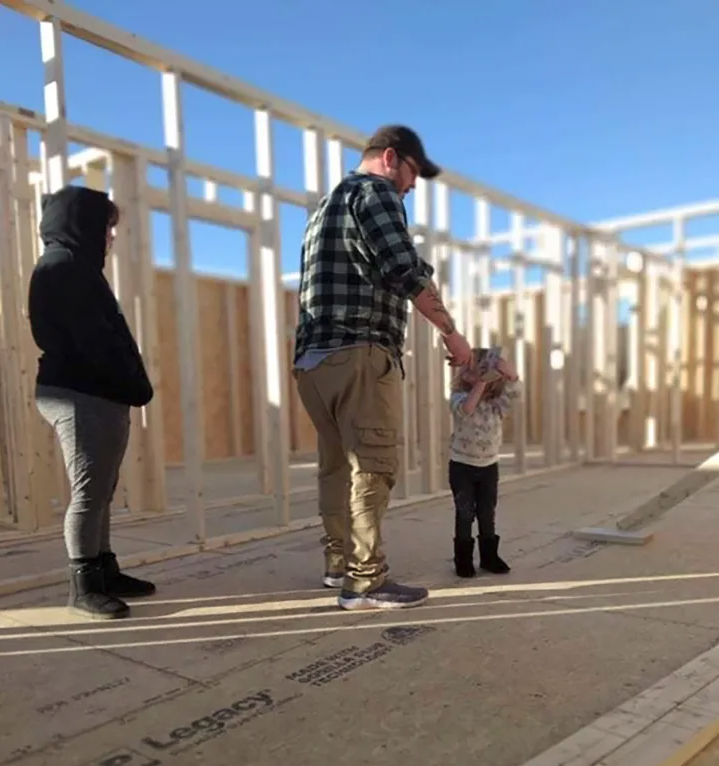Editor’s note: This story was originally published by The Daily Yonder, which has been providing news, commentary, and analysis about and for rural America since 2007. You can connect with more of their work here. You can read Kim Kobersmith’s reporting here:
Six months removed from the devastation of summer flooding in Eastern Kentucky, local leaders remain in the midst of an uphill battle. The urgent need for housing assistance shines a light on the complexity of recovery in an already challenged rural area. Their deepest hope is not just to get roofs over people’s heads but also to secure the resources to build stronger, more resilient communities going forward.
“Layered factors make the recovery really challenging, requiring a whole lot of subsidies,” explained Scott McReynolds of Housing Development Alliance (HDA) in Hazard. “We have the opportunity to get it right and economically move the needle for some of the most distressed Appalachian counties. Getting people out of substandard housing in flood prone areas, into safe, energy efficient homes, will give residents the opportunity to create wealth through housing.”
The Disaster
The flooding was caused by an unusual weather event. Previously, the North Fork of the Kentucky River in Whitesburg had crested at 14.5 feet; it was 21 feet and still rising in July when the gauge failed. According to the National Weather Service, total rainfalls in the affected areas reached up to 16” over a four-day period, an amount that is “historically unheard of.”
The Red Cross estimates more than 2,300 houses were damaged beyond repair. Local leaders say Letcher County lost 25% of its homes. Regional leaders overlaid the locations of 5,000 damaged houses with the current floodplain map and determined almost 80% of those lost were not in the floodplain, including a home that had over seven feet of water inside.
Because this was a flooding event, most residents do not have access to insurance money. Regular homeowner’s insurance doesn’t cover flooding, and FEMA reports that only 4% of those applying for housing recovery assistance had flood insurance. The maximum FEMA grant per household is less than $40,000 and it is currently the only source of funding for many residents.

McReynolds shares the example of one Knott County homeowner. His house was literally washed away. It was worth about $120,000 and he has a $60,000 mortgage on it. He had no insurance and received the $40,000 FEMA allotment. He now owes $20,000 on a house that no longer exists and a piece of flood-prone property. Land on higher ground will cost him approximately $30,000. He is facing $50,000 in mortgage obligations before he even begins to build a new home.
The Location
The hard-hit areas of Eastern Kentucky are more vulnerable to disasters than other locales. People with lower incomes don’t have the same level of access to resources and credit for their recovery that those in the middle and upper classes do. “When it comes to socioeconomic vulnerability, Eastern Kentucky is off the charts — as high as it gets,” said McReynolds. “We will have a significantly higher number of households needing deep assistance to recover.”
Compounding the problem, the region had a pre-existing housing crisis. HOMES, Inc. is a nonprofit in Letcher County. Executive Director Seth Long explained that they are the only housing developer in the area. Because of a low number of real estate transactions, appraisals on new homes usually don’t even reach the price required to build them. A region with high socioeconomic vulnerability and without a solid housing market represents too great a risk for for-profit developers.
Furthermore, many residents lived in inadequate or undervalued housing that makes it hard to qualify for recovery aid. For example, some shared property in common and didn’t hold a deed; they are not eligible for FEMA aid. Others had land contracts, a kind of rent-to-own arrangement, that has left them both without a home and without any property equity.

The Local Vision
Amid the challenge and chaos of the first months of relief efforts, McReynolds and the HDA team knew they needed to envision a better future for their community. Their manifest, “Higher Ground,” outlines the vision for a recovery that is justice-focused, culturally appropriate, and environmentally sound.
The first of their “Guiding Principles for a Lasting Recovery” recognizes that households headed by people of color, low-income earners, and women are more vulnerable to disasters and historically receive less assistance. The leaders will strive to embrace equity in the recovery.
Throughout, the principles also value the importance of place in the lives of rural Appalachian residents, recognizing that many people are deeply tied to their family hills and hollers.
“People live in homeplaces where generations have owned land,” said Foundation for Appalachian Kentucky CEO Gerry Roll. “That may not have much monetary value in the 21st century housing market, but their home has immeasurable value for that family. We can’t disregard that.”
“Higher Ground” recovery efforts will abide by, and go beyond, existing floodplain regulations in an effort to create housing resiliency for residents. In anticipation of increasing “unprecedented” rain events, it states, “It is clear that simply repairing and rebuilding homes where they were is a short-sighted, inadequate, and dangerous solution.”
The document recommends a multi-pronged approach to recovery. Options for replacing flood-prone housing include subdivisions on higher ground and smaller place-based developments. Respecting cultural ties, another option is to site homes on higher ground on family land where possible and rebuild with flood-resistant construction techniques.

Approximately 30% of impacted households were renting, and there is a real need to increase the number of available rental units as well. But Seth Long with HOMES, Inc. says building new rentals is not the whole solution. Many renters were previously in inadequate housing and can’t afford the market rate. The housing authority already had a waiting list; more supplemental vouchers need to be part of the recovery.
McReynolds believes their vision has gotten the attention of state leaders. Kentucky Governor Andy Beshear, when announcing the private donation of land for a new subdivision, acknowledged that clustered housing developments are only part of the solution.
“Housing Can’t Wait”
As with most bold, forward-looking visions, the one outlined by folks in Eastern Kentucky will require significant funding to come to fruition. Leaders see the situation as urgent since many area residents are not yet in permanent quarters. Gov. Beshear announced in an update on January 12 that 249 households, more than 660 individuals, were currently living in supplied travel trailers.
Others are living with extended family. Many are precariously housed, repairing homes that shouldn’t be repaired, or fixing up sheds to live in, to avoid being homeless. One family who has received only FEMA money is staying on their vulnerable property and fixing up the bathroom in a used trailer they acquired. People are making the best housing decisions they can with the resources they have.
Local leaders were frustrated when the Kentucky state legislature passed a flood relief package in special session and failed to include any funds designated for housing.
“The government needs to step up and say what resources are coming so people can look beyond these types of solutions,” explained McReynolds. “Committing relief money and providing a framework for how we can use it will help nonprofits create a comprehensive plan. Right now, we might be using our precious unrestricted private dollars to help people who will qualify for state or federal resources.”
“Most officials in the legislature said we don’t know what we need,” said Roll. “That is an injustice, as we have a wonderful network of housing organizations that have been working together for more than 30 years. We know how to do it right and the legislature failed to acknowledge that.”

Local partners announced a joint effort, called “Housing Can’t Wait,” to build 12 new houses, four in each of the hardest hit counties of Perry, Breathitt, Letcher and Knott. It was about more than recovery; it was a challenge aimed at elected officials. The Foundation for Appalachian Kentucky, a community foundation headquartered in Hazard, contributed more than $1 million towards the effort.
“The foundation is grounded in the region and has garnered a reputation for being a good steward,” said Roll. “People want to help after a disaster and they want their money as close to the ground as they can get it to the people who need it most. We are a trusted channel for that.”
Additionally, social investment platform Invest Appalachia has given two innovative five-year conditional repayment grants so HDA and HOMES, Inc. have quick and simple access to capital for buying property and materials. One of the biggest benefits is saving staff time and energy.
Considering the combined impact of private and corporate donations, McReynolds said HDA has received significant funding. But donations will still not meet the need. He estimates the total cost of housing recovery, including building 2,300 new homes and repairing 8,500 others, at over $629 million dollars. The Kentucky legislature is back in session for 2023, but housing advocates are unsure if any relief will be headed their way.

Area leaders anticipate these types of disasters will continue to occur more frequently and intensely due to climate change. Their experiences in Eastern Kentucky have shown the recovery system in the U.S. is not up to the task. At this turning point in the region’s history, keeping Appalachian Kentucky a viable place to live, work, and play will require the continued efforts of the local movement for a just recovery.
This article first appeared on The Daily Yonder and is republished here under a Creative Commons license.




